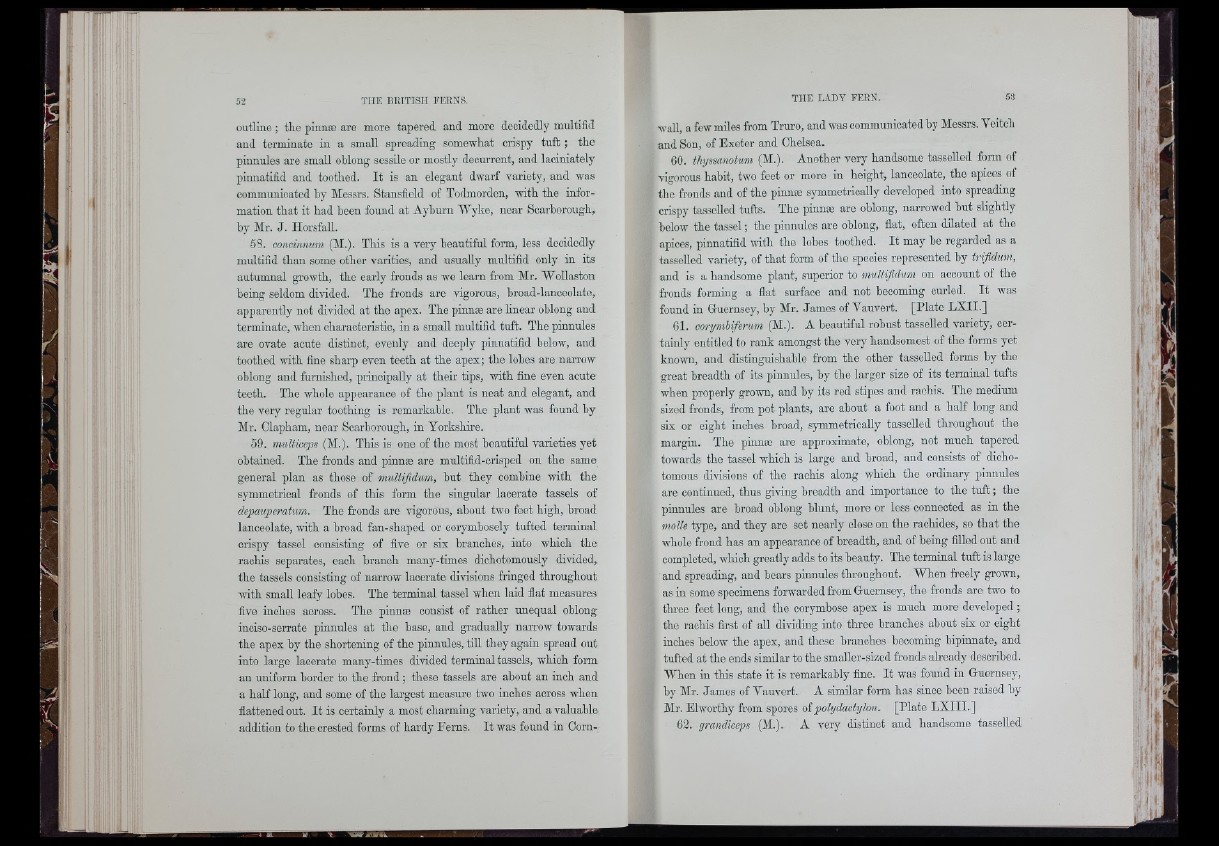
outline ; the pinnae are more tapered and more decidedly multifid
and terminate in a small spreading somewhat crispy tuft ; the
pinnules are small oblong sessile or mostly decurrent, and laoiniately
pinnatifid and toothed. It is an elegant dwarf variety, and was
communicated by Messrs. Stansfleld of Todmorden, with the information
that it had been found at Ayburn Wyke, near Scarborough,
by Mr. J. HorsfaU.
58. coHcinnimt (M.). This is a very beautiful form, less decidedly
multifid than some other varities, and usually multifid only in its
autumnal growth, the early fronds as we learn from Mr. WoUaston
being seldom divided. The fronds are vigorous, hroad-lanoeolate,
apparently not divided at the apex. The pinnæ are linear oblong and
terminate, when characteristic, in a small multifid tuft. The pinnules
are ovate acute distinct, evenly and deeply pinnatifid below, and
toothed with fine sharp even teeth at the apex; the lobes are narrow
oblong and furnished, principally at their tips, with fine even acute
teeth. The whole appearance of the plant is neat and elegant, and
the very regular toothing is remarkable. The plant was found by
Mr. Clapham, near Scarborough, in Yorkshire.
59. multiceps (M.). This is one of the most beautiful varieties yet
obtained. Tbe fronds and pinnæ are multifid-orisped on tbe same
general plan as those of multifidum, but they combine with the
symmetrical fronds of this form the singular lacerate tassels of
depauperatum. The fronds are vigorous, about two feet high, broad
lanceolate, witb a broad fan-shaped or oorymbosely tufted terminal
crispy tassel consisting of five or six branches, into which the
raohis separates, each branch many-times diohotomously divided,
the tassels consisting of narrow lacerate divisions fringed throughout
with small leafy lobes. The terminal tassel when laid flat measures
five inches across. The pinnæ consist of rather unequal oblong
inoiso-serrate pinnules at the base, and gradually narrow towards
the apex by the shortening of the pinnules, till they again spread out
into large lacerate many-times divided terminal tassels, which form
an uniform border to the frond ; these tassels are about an inch and
a half long, and some of the largest measure two inches across when
flattened out. It is certainly a most charming variety, and a valuable
addition to the crested forms of hardy Ferns. It was found in Cornwall,
a few miles from Truro, and was communicated by Messrs. Veitch
and Son, of Exeter and Chelsea.
60. thyssanotum (M.). Another very handsome tasselled form of
vigorous habit, two feet or more in height, lanceolate, the apices of
the fronds aud of the pinnæ symmetrically developed into spreading
crispy tasselled tufts. The pinnæ are oblong, narrowed but slightly
below the tassel ; the pinnules are oblong, flat, often dilated at the
apices, pinnatifid with the lobes toothed. It may be regarded as a
tasselled variety, of that form of the species represented by trifidum,
and is a handsome plant, superior to multifidum on account of the
fronds forming a flat surface and not becoming curled. It was
found in Guernsey, by Mr. James of Vauvert. [Plate LXII.]
61. corymbiferum (M.). A beautiful robust tasselled variety, certainly
entitled to rank amongst tbe very handsomest of the forms yet
known, and distinguisbable from the other tasselled forms by the
great breadth of its pinnules, by the larger size of its terminal tufts
when properly grown, and by its red stipes and raohis. The medium
sized fronds, from pot plants, are about a foot and a half long and
six or eight inches broad, symmetrically tasselled throughout the
margin. The pinnæ are approximate, oblong, not much tapered
towards the tassel which is large and broad, and consists of diohotomous
divisions of the rachis along which the ordinary pinnules
are continued, thus giving breadth and importance to the tuft ; the
pinnules are broad oblong blunt, more or less connected as in the
molle type, and they are set nearly close on the rachides, so that the
whole frond has an appearance of breadth, and of being filled out and
completed, which greatly adds to its beauty. The terminal tuft is large
and spreading, and bears pinnules throughout. When freely grown,
as in some specimens forwai’ded from Guernsey, the fronds are two to
three feet long, and the corymbose apex is much more developed ;
the raohis first of all dividing into three branches about six or eight
inches below the apex, and these branches becoming bipinnate, and
tufted at the ends similar to the smaller-sized fronds already described.
When in this state it is remarkably fine. It was found in Guernsej’,
by Mr. James of Vauvert. A similar form has since been raised by
Mr. Elworthy from spores oipolydaotylon. [Plate LXIII.]
62. grandiceps (M.). A very distinct and handsome tasselled
; t
!” if
i iü J
[M l
*1
«
. I
I '■
il
■ r |
'¡if
I I